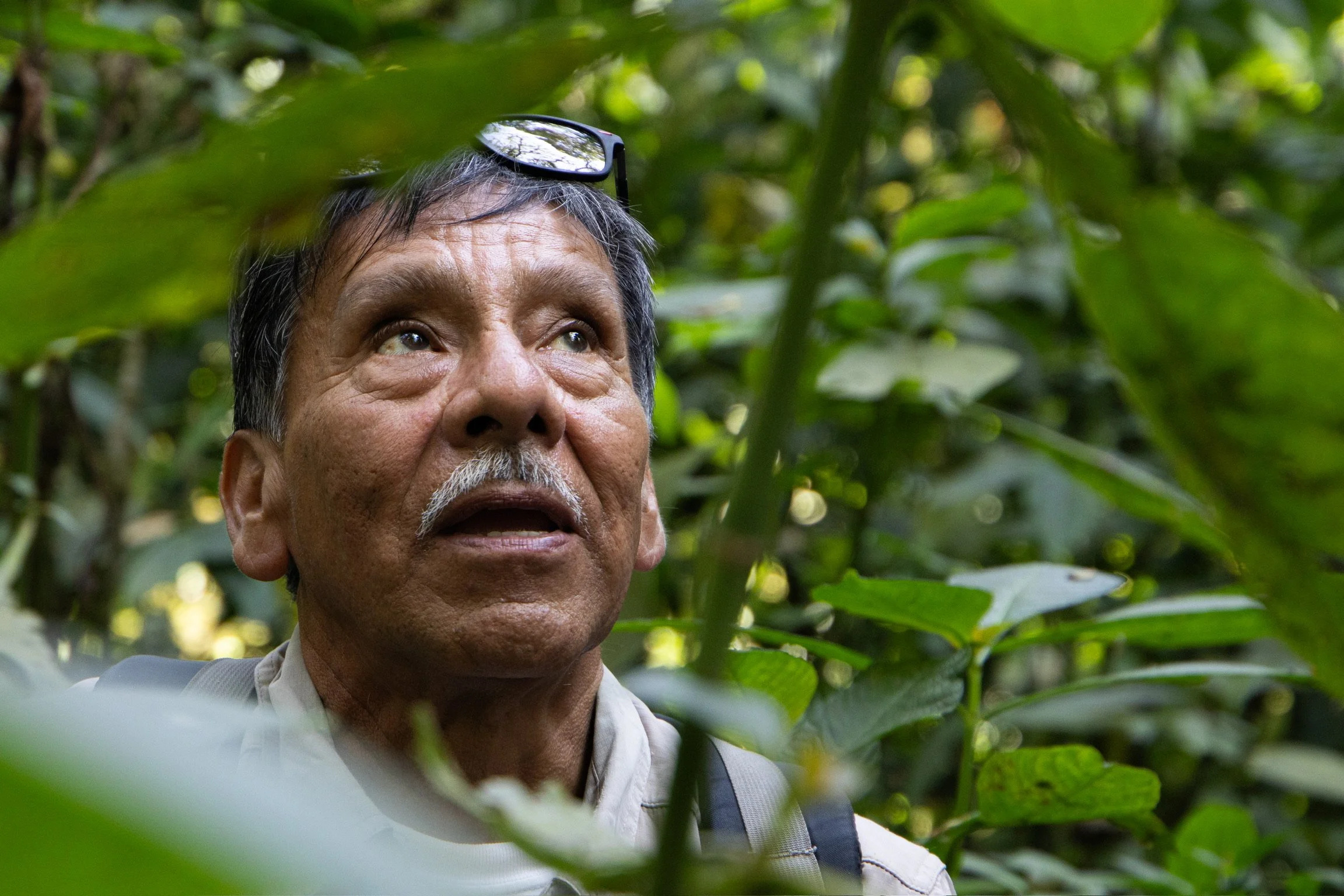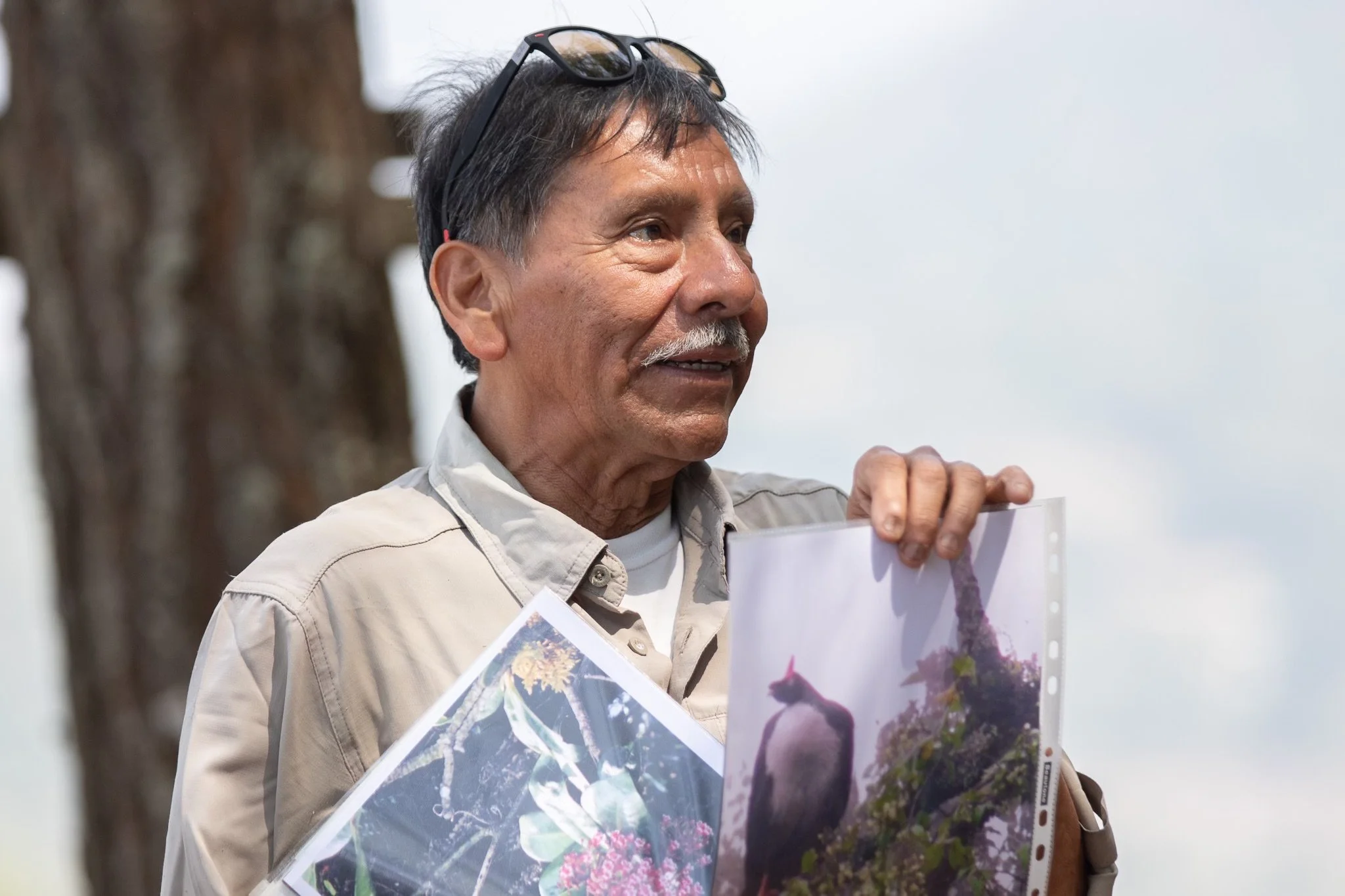Photo by Aidan Sheedy
Student and Steward
of Nature
Forest ranger Jorge Letona Protects Biodiveristy and Promotes Sustainability
By Leslie Virostek
SAN LUCAS TOLIMÁN, GUATEMALA — Steep and verdant, Cerro Iquitiu is a peak about 2,100 meters in altitude, located in Guatemala’s southwestern highlands. A birding hotspot, this cloud forest is home and habitat to a variety of flora, fauna and microorganisms, including opportunist wild orchids that nestle in the crooks and elbows of the upper canopy’s branches, various snails, mushrooms of many colors, coyotes (one translation of the mountain’s name from the Kaqchikel language is Place of Coyotes) and resplendent quetzals — Guatemala’s national bird and symbol of freedom.
More than 600 acres of this extraordinarily biodiverse place is a protected natural reserve. Its preservation as such is due, in large part, to the efforts of the municipality’s forest ranger. His name is Don Jorge Letona. A perpetual student of nature, the 62-year-old has been exploring the magic of Iquitiu Forest for more than three decades. Serene in demeanor, sage in his observations and answers to queries, he emanates a kind of quiet passion. His life’s work is conservation — not only of natural spaces like Cerro Iquitiu, but of sustainable practices passed down through generations.
One of Don Jorge’s most important conservation tools is his camera. A self-taught photographer, he has spent countless hours hiking on this and adjacent mountains and volcanoes documenting some 1,500 species. His archive contains over 2,000 images.
“We cannot do conservation work about things that we don’t know about,” he explains with the aid of an interpreter.
Don Jorge Letona holds his photo of the endangered pavo de gacho, or horned guan.
Photo by Jack Spiegel
Among his photos is one he took years ago of the pavo de gacho. Known in English as the horned guan, these endangered birds have been dubbed “the unicorns of the cloud forest.” The epithet acknowledges both their scarcity — as they are among the planet’s rarest birds, found only at certain altitudes of volcanic peaks in southern Guatemala and an adjacent Mexican province — and their odd appearance. Over 30 inches long, these black and white, turkey-shaped avians have a distinctive reddish horn, like a small, fleshy traffic cone, on the top of their heads.
In recent years their numbers have been dwindling due to habitat disturbance and destruction. Could there be any of those unicorns on Cerro Iquitiu today? Don Jorge thinks so, and he is keen to prove it. His creased face lights up with boyish radiance when he describes his plan to make the forest more hospitable for them: On his tromps through the forest he’s been collecting the seeds of the aguacatillo tree — the variety of wild avocado whose acorn-sized fruit is the birds’ favorite food. He’ll plant a nursery of seedlings, transplant them to the mountain, watch and wait.
Don Jorge’s knowledge about growing things runs vast and deep. In addition to being a forest ranger, he is a long-time teacher of agricultural practices, working for Guatemala’s Ministry of Agriculture. His two jobs enable him to nurture life in both natural areas and in cultivated places, and he sees the two as closely related. Biodiversity, for example, is crucial to good ecology everywhere.
“I believe that monocultures are not good for the earth or for our health,” he says. “We need to diversify.”
He gives coffee as an example. Many farmers in Guatemala have forgone food crops in favor of growing coffee. But a cash crop puts growers at the mercy of the markets. High prices and profitability are not guaranteed. What’s more, farmers tend to turn to, and become reliant upon, chemical interventions to maintain their monoculture operations.
“So this forces you to keep filling the pockets of the people that make chemical fertilizer,” he says.
Such an agricultural model is both ecologically unsustainable and financially untenable for an agricultural workforce that is neither growing crops it can eat, nor earning enough to provide a decent quality of life.
Don Jorge remembers a time when more farmers preferred natural solutions. Back then, the best way to repel a pesky agouti, a large rodent known locally as a gatuza, was to put a combination of garlic and chili peppers into holes dug around the crops.
In the old days, [farmers] were a lot more ecological than they are now,” he says.
Agriculture can deplete the soil of important nutrients, but Don Jorge has found that forests like Iquitiu can be a resource to farmers. Dry leaves from the forest floor, for example, can be collected and incorporated into compost.
“There are farmers who are only thinking about the harvest and not thinking about the biodiversity of leaves that will make their fertilizer nutrient rich,” he says. “It not only helps the harvest, it also helps regenerate the soil.”
He recently advocated for this technique on a consulting project that involved vermicomposting. It’s a method in which earthworms eat and digest rotten vegetables and other food waste. Their droppings — called castings — create a rich mixture of organic fertilizer. Having previously brought some worms to add to the compost, he was dismayed to learn that they were too small to do their job of munching through the refuse. So Don Jorge advised his collaborators to incorporate leaves from their region, whose forests happen to feature a species of evergreen oak known as an encino.
He says with a wide grin, “And they brought lots of those leaves, and two months later it was incredible to see the size of the worms, how big they got!”
Don Jorge believes not only in a connection between forests and farmlands but also a kind of reciprocity. He and a friend have grown — and are preparing to plant — 200 encino seedlings in areas where human activity has been detrimental.
“We have to give back to the forest,” he says, “We take a lot from it and we want to give back to it.”
A few miles to the west of Cerro Iquitiu is the town of San Lucas Tolimán, the place where Don Jorge was born and where he still lives today. He says his foundational knowledge about all living things was passed down from his grandfather, the manager of a large coffee farm. From him, Don Jorge learned how to plant corn and other crops, how to use various tools and how to chop wood for his grandmother, just the way she liked it — thin.
“My grandfather, he was the one who taught me,” he says, “and I was always happy being in nature.”
During the coffee harvesting season, Don Jorge worked in the fields to earn money to buy notebooks for class. After high school, his dream of studying agronomy was not an option offered by the local educational institutions. His only choices were to become an accountant or a teacher. Because of his self-described “shy personality,” he was leaning toward the former. However, an influential uncle believed the thoughtful young man had the makings of an educator, so Don Jorge dutifully changed course and completed his training to become a licensed schoolteacher.
Before he could begin, however, he heard about an opening at the Ministry of Agriculture. Giving him an opportunity to employ his head, hands and heart, the position capitalized on the gifts identified by his prescient uncle and on Don Jorge’s love for the natural world.
Meanwhile, Guatemala’s government was creating new laws related to conservation, particularly combating the scourge of rapid deforestation. Passed in 1989, the wide-ranging and consequential Law of Protected Areas identified ecologically important zones and brought into being the National Council for Protected Areas, known as CONAP. This body is responsible for the management of the unified System of Protected Areas in Guatemala, and its mandate includes preventing poaching and conducting education and training programs related to conservation, restoration and forest fire prevention.
One day in 1990 CONAP representatives came to the Ministry of Agriculture with the intent of hiring Don Jorge as the designated forest ranger for San Lucas Tolimán.
“Don Jorge already has a job,” the ministry protested, fearful of losing one of their most knowledgeable employees. But CONAP insisted, not wanting this capable conservation advocate to be the one that got away.
Don Jorge during a visit to Cerro Iquitiú in January 2024.
Photo by Margarita Díaz
So Don Jorge found himself with two jobs and two salaries.
He says, “That was the moment that I bought my camera. And I started making a huge photography archive, the biggest one in [the Department of] Sololá.”
His photographs would become key evidence in a presentation he made to persuade the government of San Lucas Tolimán that Cerro Iquitiu’s biodiversity was both valuable and worth preserving. Town leaders went on to petition CONAP to include the cloud forest among its designated protected areas, now numbering about 150.
In addition to all of his solo ramblings, Don Jorge has served as a guide to various groups—biologists from the University of San Carlos who wanted to take inventories of plants and animals, for example, and groups of students. He has also brought together all of Solalá’s 18 rangers — one for each municipality — for projects such as trail maintenance.
Always he is looking to nature. What he has seen in recent years is the impact of climate change. Cloud forests like the one on Cerro Iquitiu are a type of tropical, high-altitude rainforest. They act as water reserves that are critical to sustaining the ecosystems of the region. They draw moisture from the Pacific Ocean, creating clouds whose precipitation filters through the trees in what is sometimes called horizontal rain. Even during Guatemala’s dry season, November to April, humidity would normally be present. But on a hot day this past March, the winding trail to the lookout that offers views of Lake Atitlán was dry enough that foot traffic caused dust to hang in the air and cling to clothing. Drought is an issue like never before.
“We can see climate change impacting this cloud forest,” he told the group of students he was guiding. “Now it’s not so sure, but back in the day we knew that by 11 a.m. it would be full of clouds.”
When he’s not hiking steep trails, creating organic compost, or visiting his friend the beekeeper across the lake in San Juan La Laguna, Don Jorge is at his home, just down the street from where his 91-year-old mother lives.
It is located in the center of San Lucas Tolimán, today a town of about 17,000 people, whose litter-strewn streets are lined with square, flat-roofed buildings, cement walls, a preponderance of corrugated tin, and numerous shops that sell American junk food—from Doritos in a dozen flavors to Coca-Cola and other sugary drinks. Notwithstanding a few colorful doors, some tidy establishments, a lakeside park and a landscaped central square, this town is not conventionally pretty.
But if you go through the black iron door and pass through the high wall to Don Jorge’s courtyard and home, you enter another world. Here, flowering trees drop their blossoms on the ground like purple snow, an extensive green canopy provides welcome shade, and cheerful little plants and flowers hang from nearly every tree branch.
The fairy population in this magical place is unknown. But Don Jorge’s last botanical census in 2009 tallied some 500 individual plants, including those in pots lining the walkway and the many bonsai trees and succulents in the rooftop garden.
“The care that each plant requires is personal, each one requires its own care,” Don Jorge declares, as he shows visitors some of his beloved specimens.
“And I also allow them to live with other plants. Remember that, below, plants have roots and they make networks, natural networks. They help each other. For example this pine can provide fertilizer for the other plants that grow with it.”
Don Jorge believes that each of his plants requires personal care.
Photo by Aidan Sheedy
He pauses before adding, “This is also an example of how we should live as humans. We need to help each other.”
Guatemala has recently embraced some significant international environmental agreements. In March of 2022, for example, the country sent a delegation to participate in negotiations of the Global Biodiversity Frameworks 2022-2030 in Geneva.
But Don Jorge would like to see more importance placed on conservation and sustainable approaches to agriculture. Guatemala is one of the most biologically diverse nations on Earth, and so much more could be done to protect its 14 different ecoregions. He finds it discouraging that local authorities have so little interest in the treasure that is Cerro Iquitiu.
But he says he hopes for three things that will lead to a brighter future for the planet: “Education, education and more education.”
As a government employee for more than 35 years, Don Jorge could retire with a nice little pension. But he’s not thinking about the money so much as continuing his life’s work protecting and nurturing forest habitats and promoting good ecological practices.
He says, “I’m 62 years old and I hope that I can keep walking and getting to know new places. My dream is to keep getting to know more of nature.”




